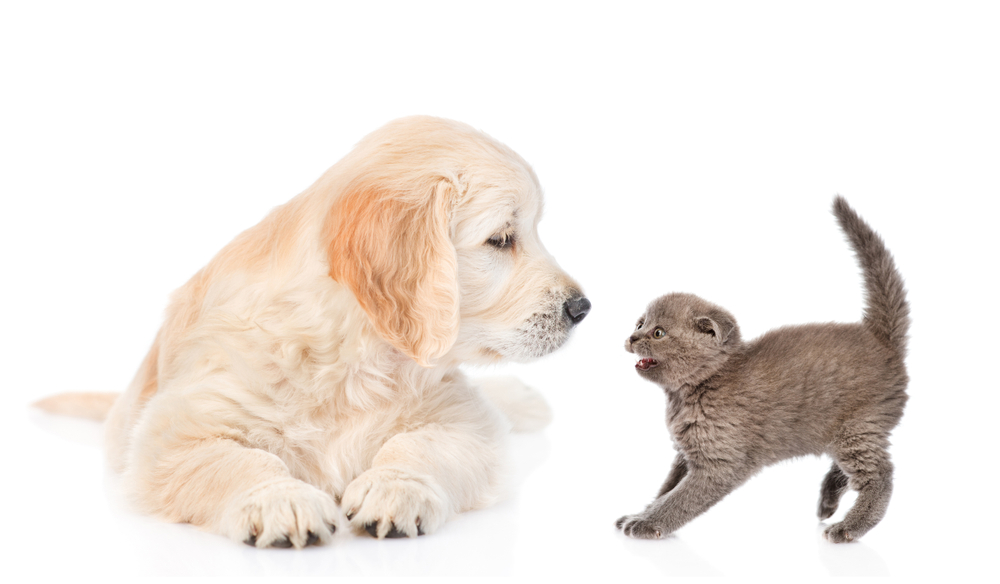The relationship between dogs and cats is, well, a turbulent one. While there are stories here and there of canines and felines who are practically inseparable, for the most part, it’s well-known that the two aren’t exactly the best of friends. After all, the saying “fighting like cats and dogs” didn’t come about for nothing.
But why don’t dogs and cats get along? What is it that makes some cats and dogs hit it off, but not others? And if you’d like to have a cat and a dog, how can you introduce the two?
Let’s find out!
Why don’t dogs and cats get along?
The reason why dogs and cats don’t get on is steeped in their very long history. It all comes down to their behaviour as wild animals many moons ago, as well as how we domesticated them.
In the wild, dogs relied on their prey drive to survive. They hunted small animals – like cats – for food, and that instinct remains. Cats, on the other hand, would flee from animals that hunted them or retaliate with behaviours like hissing and swiping. So, when confronted by one another even today, both animals are hard-wired to rely on their innate behaviours in order to live.
Once we started domesticating dogs and cats thousands of years ago, the rivalry went even further. The two would compete with one another for food and attention from humans, leading to more hostility. Nowadays, both animals may continue to fight to be at the top of the home hierarchy and assert their dominance as the top dog (or cat).
As well as their ingrained behaviours, dogs and cats have very different ways of communicating. This can cause a lot of confusion between the two species. Here are a few examples of what miscommunication between dogs and cats can look like:
- Cats purr as a sign of contentment, but dogs may perceive that as growling and aggression
- Dogs tend to avoid eye contact with one another in order to prove that they’re not a threat. On the other hand, cats actively make eye contact to communicate the same thing
- A dog may show signs that it wants to play. But a cat will see this as a sign of wanting to attack
Can some dogs and cats get along?
Now that we’ve figured out the answer to “Why don’t cats dogs and cats get along?” you may be wondering if that’s true of all dogs and cats.
While not really the norm, some dogs and cats can live in harmony just fine. The best case scenario is that they become tight friends, playing, sharing food, or even dozing together. More often than not, though, many dogs and cats will simply remain indifferent to one another and co-exist.
The factors that contribute to whether or not dogs and cats will get on include the age that they met, the breed of dog, and the personalities of both pets.
Generally speaking, it’s easier for cats and dogs to build a rapport if they’ve been brought up together. When puppies and kittens are very young, they go through the socialisation period whereby they learn certain behaviours and how to interact with others.
For puppies, this happens around 5-12 weeks old, and for kittens, 4-8 weeks old. If dogs and cats meet before or during this period (and as long as there are no negative interactions), they may very well learn to get along.
There are also certain breeds of dogs that tend to be better with cats. These cat-friendly dogs include Cavalier King Charles Spaniels, Basset Hounds, Pugs, Chihuahuas, and Poodles. The reasons why these dogs are good with cats include the fact that they’re friendly, relaxed, or very easy to train – so you can teach them to stay away from a cat if need be.
Often, though, the reason why certain dogs and cats are happy to be around one another is that their personalities are well-suited. Some dogs are naturally less likely to scare a cat through chasing. Some cats are less territorial and more open to interacting with dogs.
How to introduce a dog and cat to one another
Already a Cat Owner and considering a dog, or vice versa? Obviously, getting both pets at a young age is one of the best ways to encourage them to get on. But if that’s not possible, there are a few things you can do to promote harmony in the home.
A friendly relationship between your pets isn’t necessarily a given. However, with some handy tips up your sleeve, they may get along just fine.
- Ensure your dog is well-trained and well-exercised. Teaching your doggo a few easy dog tricks like “sit”, “heel”, and “stay” can help you control certain behaviours when they’re making moves on your cat. Exercise is also key for your dog. Giving your dog an outlet for all their energy will mean they’re calmer and more relaxed at home – and thus less likely to lash out at your cat. Don’t have time to exercise them every day? That’s where the services of a local Dog Walker can really come in handy!
- Make sure your cat has their own space. If your pooch does decide to jump up or chase your cat, you’ll want to ensure your kitty has plenty of places to retreat to. Cat trees are ideal, as they’re often high enough that your dog can’t reach them. Alternatively, your cat may opt to jump up on high shelves or the tops of cupboards to get away
- Keep their belongings separate. Given their history of competing for food, it’s best to give your dog and cat separate feeding areas. Ideally, in totally different parts of your home. Keep their toys and sleeping spots separate, too. As well, try to avoid letting your dog go near your cat’s litter. Cats like privacy when they’re doing their business.
And if you’re looking for more advice, make sure to check out our guide to introducing your cat to a second pet and our tips on getting your dog to like cats. You may have a bit of work ahead of you, but the results could very well be worth it!


